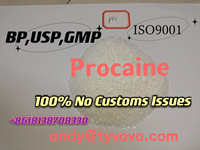
Procaine Powder
English name: PROCAINE
CAS No.: 59-46-1
Molecular formula: C13H20N2O2
Molecular weight: 236.31
EINECS number: 200-426-9
Melting point 61°
Boiling point 378.78 ° C (rough estimate)
Uses Local anesthetics. Its toxicity is low and its effect is fast and safe. It is suitable for local anesthesia and is used in eye, ear, nose and tooth surgery for infiltration anesthesia, conduction anesthesia and closure therapy. This product is also used to produce procaine penicillin.
Procaine is an anesthetic agent indicated for production of local or regional anesthesia, particularly for oral surgery. Procaine has the advantage of constricting blood vessels which reduces bleeding, unlike other local anesthetics like lidocaine. Procaine is an ester anesthetic. It is metabolized in the plasma by the enzyme pseudocholinesterase through hydrolysis into para-aminobenzoic acid , which is then excreted by the kidneys into the urine.
CAS No.: 59-46-1
Molecular formula: C13H20N2O2
Molecular weight: 236.31
EINECS number: 200-426-9
Melting point 61°
Boiling point 378.78 ° C (rough estimate)
Uses Local anesthetics. Its toxicity is low and its effect is fast and safe. It is suitable for local anesthesia and is used in eye, ear, nose and tooth surgery for infiltration anesthesia, conduction anesthesia and closure therapy. This product is also used to produce procaine penicillin.
Procaine is an anesthetic agent indicated for production of local or regional anesthesia, particularly for oral surgery. Procaine has the advantage of constricting blood vessels which reduces bleeding, unlike other local anesthetics like lidocaine. Procaine is an ester anesthetic. It is metabolized in the plasma by the enzyme pseudocholinesterase through hydrolysis into para-aminobenzoic acid , which is then excreted by the kidneys into the urine.
Certificate
- BP
- ISO9001
- USP
- GMP
Main Products
Tetracaine lidocaine procaine benzocaine phenacetin
